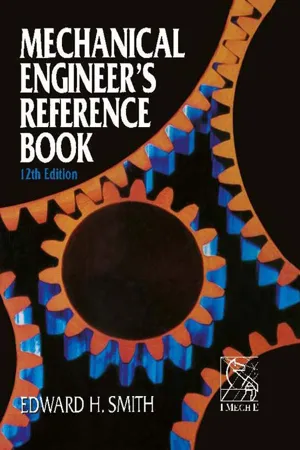
- 1,190 pages
- English
- ePUB (mobile friendly)
- Available on iOS & Android
Mechanical Engineer's Reference Book
About this book
Mechanical Engineer's Reference Book, 12th Edition is a 19-chapter text that covers the basic principles of mechanical engineering. The first chapters discuss the principles of mechanical engineering, electrical and electronics, microprocessors, instrumentation, and control. The succeeding chapters deal with the applications of computers and computer-integrated engineering systems; the design standards; and materials' properties and selection. Considerable chapters are devoted to other basic knowledge in mechanical engineering, including solid mechanics, tribology, power units and transmission, fuels and combustion, and alternative energy sources. The remaining chapters explore other engineering fields related to mechanical engineering, including nuclear, offshore, and plant engineering. These chapters also cover the topics of manufacturing methods, engineering mathematics, health and safety, and units of measurements. This book will be of great value to mechanical engineers.
Frequently asked questions
- Essential is ideal for learners and professionals who enjoy exploring a wide range of subjects. Access the Essential Library with 800,000+ trusted titles and best-sellers across business, personal growth, and the humanities. Includes unlimited reading time and Standard Read Aloud voice.
- Complete: Perfect for advanced learners and researchers needing full, unrestricted access. Unlock 1.4M+ books across hundreds of subjects, including academic and specialized titles. The Complete Plan also includes advanced features like Premium Read Aloud and Research Assistant.
Please note we cannot support devices running on iOS 13 and Android 7 or earlier. Learn more about using the app.
Information
Table of contents
- Cover image
- Title page
- Table of Contents
- Copyright
- Preface
- Contributors
- Chapter 1: Mechanical engineering principles
- Chapter 2: Electrical and electronics principles
- Chapter 3: Microprocessors, instrumentation and control
- Chapter 4: Computers and their application
- Chapter 5: Computer-integrated engineering systems
- Chapter 6: Design standards
- Chapter 7: Materials, properties and selection
- Chapter 8: Mechanics of solids
- Chapter 9: Tribology
- Chapter 10: Power units and transmission
- Chapter 11: Fuels and combustion
- Chapter 12: Alternative energy sources
- Chapter 13: Nuclear engineering
- Chapter 14: Offshore engineering
- Chapter 15: Plant engineering
- Chapter 16: Manufacturing methods
- Chapter 17: Engineering mathematics
- Chapter 18: Health and safety
- Chapter 19: Units, symbols and constants
- Index